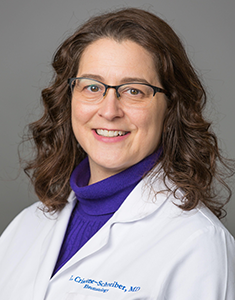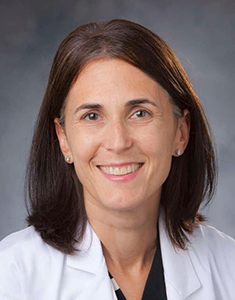
The Internal Medicine Residency program in the Duke Department of Medicine (DOM) is transforming its training structure to better reflect the work residents will be doing in their future. Beginning summer 2026, the program aims to implement a “4 plus 4” structure to improve training experiences in ambulatory and consultative medicine.
“A majority of patient care provided by internal medicine physicians already occurs in the ambulatory/outpatient setting and increasing training in those areas will better prepare our residents for the practice they will undertake,” said Lisa Criscione-Schreiber, MD, vice chair for Education in the Duke Department of Medicine.

Education leaders are moving the program to a 4+4 model to allow residents to spend 4 weeks in the inpatient setting, followed by 4 weeks in an ambulatory/outpatient and specialty consultative settings, like a clinic or in another subspecialty. “We want to build the same strengths of the inpatient portion into the outpatient portion of the program,” said Aimee Zaas, MD, professor of Medicine, Internal Medicine Residency Program director.
Leaders are preparing for the Accreditation Council for Graduate Medical Education (ACGME) to update its program requirements to include more ambulatory training in the coming years.
They anticipate that the 4+4 model will improve patient care, especially for those in primary care clinics, and focusing on teamwork and decreasing interruptions, will make residents more essential to clinics and consultative teams, which will bolster their relationships with each other and enhance their confidence.

“It's hard for the residents to really feel a lot of ownership and gain traction in some clinics because they're there infrequently, and that doesn't make for a great agency type experience,” Dr. Zaas said. “The consequence is that our structure makes it harder for the physician-patient relationship to develop over time. It's much more likely the patient is going to come back and see somebody else than you, which misses out on the best aspects of primary care.”
ACGME guidelines currently require residents to spend one third of their time in an ambulatory/outpatient setting during an internal medicine residency program. As a result, several programs across the country, including Duke, adopted a 4+2 model, with residents spending 4 weeks in the inpatient setting, followed by 2 weeks in an ambulatory/outpatient setting.
The Duke program has been operating on the 4+2 model for the past eight years, which has some drawbacks. “On the inpatient side, residents are always on a team that has other residents on it. You're sharing responsibilities. You're not by yourself with faculty, and that's a real boost to the culture,” Dr. Zaas said. “In contrast, on the outpatient side, there's a lot of residents who are on the same rotation at the same time, but they're in all different places, working on their own thing, and not collaborating.”
Leaders are bringing resident wellbeing to the forefront of the internal medicine residency program after a core values assessment and data gathered over the years revealed that residents thrived when working together and working on things that are vital part of a clinic’s success.
Collaboration
Drs. Criscione-Schreiber, Zaas, Jenny Van Kirk, MD, assistant professor of Medicine, associate program director for inpatient medicine, and Denise Pong, MD, MPH, assistant professor of Medicine, associate program director for ambulatory medicine began holding retreats last year to gain additional insights into how best to build the residency program on a 4+4 model.
“The sessions have been phenomenal, we’ve gained a lot from our brainstorming sessions,” Dr. Zaas said. “Our team is very engaged and motivated, and all view this with slightly different lenses based on their experience and what they do, so that’s been tremendously helpful.”
Members of the DOM community including faculty, and previous chief residents are collaborating on the effort, with trainees set to join in the upcoming planning sessions.
“I’m hopeful that we’ll be able to pilot a few of the ideas that come from this group in the +2 model during the upcoming year,” Dr. Zaas said.
Starting next month, Kathleen Cooney, MD, chair of the Duke Department of Medicine, and Dr. Criscione-Schreiber will be attending divisional faculty meetings to discuss the program and receive feedback about the planned structure and other education initiatives.
“This new structure represents a change in training that will better align with how medicine is already practiced,” Dr. Criscione-Schreiber said.
Faculty, staff, and trainees interested in participating in the working groups are encouraged to reach out to Dr. Criscione-Schreiber for additional information.